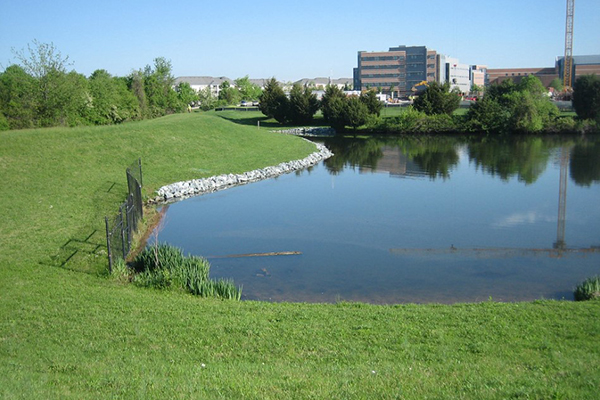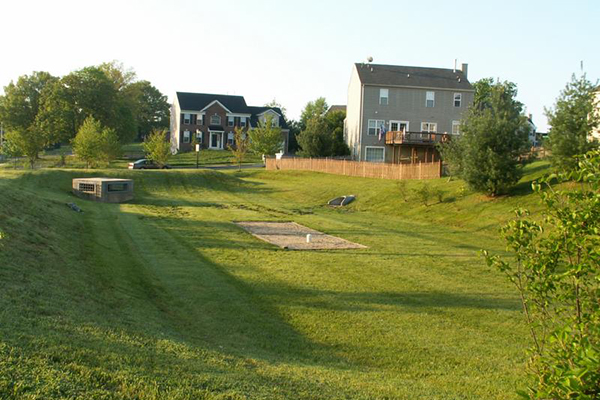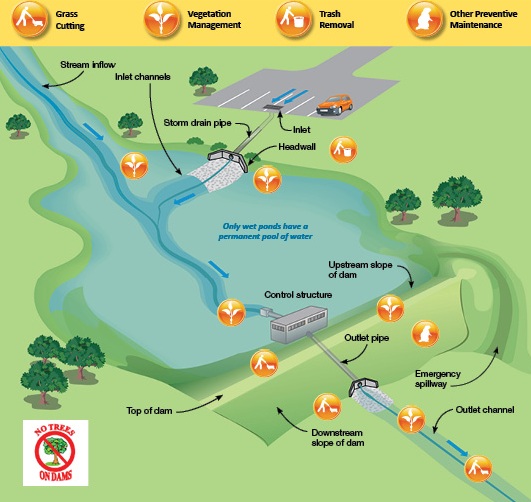Stormwater Ponds
Stormwater ponds are designed to efficiently collect rainwater and pollutants, playing a crucial role in preventing downstream flooding.
- Wet Ponds Wet ponds will always have a pool of water.

- Dry Ponds Dry ponds only fill up after rain events.

Ponds have an embankment (called a dam) to hold back water that is entering the pond. Most dams are earthen (not concrete) and are grass covered. All stormwater ponds also have a control structure that releases water at a much slower rate than the stormwater entering the pond. While water remains in the pond, pollutants have time to settle at the bottom.
Most ponds located throughout Montgomery County are stormwater management ponds, even ones that are community amenities. Ponds can have many different designs, including ponds with concrete channels, dry ponds with sand filters on the pond bottom, and ponds that provided wetland habitat around the edges.
Why are Stormwater Ponds Important?
Stormwater ponds are important stormwater management tools, because they:
- Remove pollutants
- Improve health of streams and rivers
- Help to make our waters fishable and swimmable
- Improve the quality of the Chesapeake Bay
Maintenance
 Maintenance is crucial to ensure the proper functioning of stormwater ponds. As a property owner, you are responsible for maintaining your stormwater pond, unless a shared maintenance agreement has been made with the DEP Stormwater Facility Maintenance Program. Ponds at County facilities and schools fall under the maintenance responsibility of the Department of Environmental Protection, while those in County parks are shared between DEP and M-NCPPC. Regular maintenance, including grass cutting, trash removal, and vegetation management, is necessary to keep stormwater ponds in good condition. Unmaintained ponds can lead to various issues, such as reduced pollutant removal, downstream flooding, erosion, and the unsightly growth of unwanted weeds and algae.
Maintenance is crucial to ensure the proper functioning of stormwater ponds. As a property owner, you are responsible for maintaining your stormwater pond, unless a shared maintenance agreement has been made with the DEP Stormwater Facility Maintenance Program. Ponds at County facilities and schools fall under the maintenance responsibility of the Department of Environmental Protection, while those in County parks are shared between DEP and M-NCPPC. Regular maintenance, including grass cutting, trash removal, and vegetation management, is necessary to keep stormwater ponds in good condition. Unmaintained ponds can lead to various issues, such as reduced pollutant removal, downstream flooding, erosion, and the unsightly growth of unwanted weeds and algae.
To ensure the continued effectiveness and safety of stormwater ponds, it is essential to promptly address any maintenance needs. Utilizing the services of DEP-approved contractors for structural maintenance is mandatory, and it is recommended for non-structural maintenance. By taking proper care of stormwater ponds, we can preserve the ecological balance, protect our properties, and contribute to the overall well-being of our communities and the environment.
The graphic shows some of the important structural parts of a stormwater pond and how it functions. It also highlights some of the areas and structures that may require maintenance.
Maintenance Do's and Don'ts
Do
- Regular Grass Cutting: Mow grass in the pond area at least twice a year, including the downstream slope of the dam, top of the dam, upstream slope of the dam (for dry ponds only), 25 feet around the control structure (for dry ponds only), inlet channels, around headwalls, and pipes within the pond area, and the outlet channel.
- Vegetation Management: Manually remove all trees and woody vegetation at least twice a year from the top, upstream and downstream slopes of the dam, inlet and outlet channels, within 25 feet of the control structure, and from channels, headwalls, and pipes into the pond area.
- Trash Removal: Regularly remove trash and debris from all areas in and around the pond, ensuring a clean and well-maintained environment.
- Preventive Measures: Know the pollutant sources on your property and try to reduce or eliminate pollutants at the source. Prevent trees and woody vegetation from growing in specific areas mentioned in the Vegetation Management section. Seed and cover adjacent areas of bare soil to prevent erosion. Inspect the facility after every major storm and notify the Department of Environmental Protection (DEP) if any concerns arise.
Don't
- No Herbicides, Fertilizers, or Pesticides: Refrain from applying herbicides, fertilizers, or pesticides in or around the pond. If manual removal of invasive weeds has been ineffective, limited applications of aquatic-friendly herbicides may be applied by a qualified professional certified by the State of Maryland. Check with the Maryland Department of Agriculture (MDA) for licensed companies.
By following these do's and don'ts, you can ensure the proper maintenance of your stormwater pond, helping protect the environment, local streams, and the Chesapeake Bay while staying in compliance with Montgomery County regulations. Regular upkeep ensures your stormwater pond functions effectively and remains an asset for your community.
Maintenance Checklist
How Will I Know What Maintenance is Required?
Montgomery County regulations require that you perform ongoing routine grass cutting, trash removal, and vegetation management of your stormwater facility. If the work described below is not done regularly, you could receive a notice of violation.
Need Help with Basic Pond Maintenance and Troubleshooting? Download the Fact Sheet
Grass Cutting and Vegetation Management
- ✔ Mow grass in the pond area at least twice a year.
- ✔ Manually remove all trees and woody vegetation from specified pond areas twice a year.
- ✗ Avoid neglecting the downstream slope of the embankment, as it's a commonly forgotten area that needs attention.
Trash Removal
- ✔ Regularly remove trash and debris from all areas in and around the pond on a monthly basis.
- ✔ For wet ponds, ensure any trash in the water is safely removed by professionals.
Preventive Maintenance
- ✔ Identify pollutant sources on your property and take steps to reduce or eliminate them at the source.
- ✔ Notify DEP if you observe beaver activity or animal burrowing near the pond.
- ✔ Prevent trees and woody vegetation from growing in the specified areas mentioned in the Vegetation Management section
- ✔ Seed and cover adjacent areas of bare soil to prevent erosion.
- ✔ Report any instances of graffiti to Montgomery County police for appropriate action.
- ✔ Verify that all pond safety signs are in place and visible.
- ✔ Regularly inspect the facility after every major storm and promptly contact DEP if you have any concerns.
Remember, adhering to these basic maintenance actions will keep your stormwater pond functioning efficiently and prevent the need for more serious repairs, ultimately saving you money in the long term. By taking proper care of your stormwater pond, you are contributing to a healthier environment, protecting local water bodies, and supporting the overall well-being of your community.
Structural Maintenance
Structural maintenance plays a crucial role in ensuring the proper functioning and safety of stormwater ponds. To maintain structural integrity and compliance with safety regulations, it is essential that only contractors approved by DEP perform structural maintenance tasks. No one should attempt to remove control structure manholes or enter the control structure without the necessary training, certification, and permits for confined space entry. Engaging in such activities without meeting these requirements is a violation of State law and poses potential dangers, even fatal risks.
When inspecting your stormwater pond for structural maintenance needs, keep an eye out for the following issues:
- Missing pond safety signs, which are vital for public awareness and safety.
- Accumulation of sediment and debris within the pond, which can hinder the pond's efficiency.
- Damaged or corroded trash racks, which can impede water flow and increase pond maintenance needs.
- Shoreline erosion on the dam embankment, which may weaken the structure over time.
- Dry ponds holding water longer than 72 hours, which might indicate a structural problem.
- Damaged or clogged inlet and outlet channels, pipes, and trash racks, affecting water flow.
- Leaking control structures and pipe joints, causing water loss and potential pond issues.
- Cracks or damage to the concrete control structure, requiring immediate attention and repair.
For more serious structural issues that necessitate immediate attention, please notify DEP as soon as possible. These include:
- Cracks or sinkholes on the dam embankment, which may indicate instability.
- Beaver lodges in the wet pool blocking outlet pipes, disrupting water flow.
- Damaged or broken control structure, potentially leading to significant pond malfunctions.
- Animal burrows in the dam embankment, weakening the structure's stability.
- Slope failure on the dam embankment, posing potential safety risks.
- Missing manhole covers on the control structure, which could lead to accidents or injuries.
By promptly addressing structural maintenance issues, you can ensure the effectiveness of your stormwater pond and contribute to the safety and well-being of your community and the environment. Remember to rely on DEP-approved contractors and prioritize safety when conducting any structural maintenance activities.
Need assistance with pond structural maintenance?
Our Stormwater Facilities Maintenance Program is here to help! We take responsibility for maintaining all public stormwater facilities, as well as private facilities that have transferred their maintenance to the County. Additionally, facilities required as part of the Department of Planning permits fall under our care. If you're unsure whether your stormwater pond is part of our program, you can check our online Facilities Map or reach out to us via email at [email protected].
We are committed to ensuring the proper functioning and safety of stormwater ponds, and our team is ready to provide the support and expertise you need. Download the Fact Sheet to learn more about how we can assist you with your pond's structural maintenance. (PDF, 1.07MB)
Can I remove my stormwater pond after installation?
No, you cannot remove any facilities that were part of your building installation. These stormwater ponds are permitted structures, and the Department of Environmental Protection (DEP) maintains a database of their locations as part of the Stormwater Facility Maintenance Program. If your stormwater pond is a permitted structure, DEP will conduct regular maintenance inspections to ensure its proper functioning and compliance with regulations. Before making any major changes to the structure, property owners must contact DEP and seek approval for any modifications or alterations to the pond. It is essential to follow the necessary procedures to ensure the continued effectiveness of the stormwater pond and protect the environment and local water bodies.
Concerns about Mosquitoes
Stormwater management facilities are sometimes associated with increased mosquito populations due to the presence of rainfall runoff. However, when designed and maintained correctly, these facilities should not contribute to excessive mosquito population. The Department of Environmental Protection (DEP) has developed a webpage and brochure providing information on how to identify if mosquitoes are coming from a malfunctioning stormwater management facility and ways to prevent such issues. The webpage also includes general information on mosquito biology and prevention. To learn more, visit the County's Mosquitoes webpage.
Safety - Signs and Fencing
For public safety, specific regulations are in place regarding signs and fencing around stormwater ponds. According to the Montgomery County Code, Chapter 19, Article II, Section 19-28(d)(2), the Montgomery County Department of Environmental Protection (MC DEP) must inspect fences or safety devices. If any deficiencies are found, property owners are required to address them. Additionally, Chapter 36 of the Montgomery County Code, known as Pond Safety, states that any publicly accessible pond must have warning signs posted on all sides and at major approaches, such as paths, if the pond is not surrounded by a continuous, permanent fence or barrier.
While the Montgomery County Code does not mandate the installation of fences around ponds, if fences are present as part of a stormwater management facility, they must be regularly inspected and maintained to ensure their effectiveness and safety according to MC DEP standards. By adhering to these safety measures, we can create a secure and well-maintained environment around stormwater ponds, enhancing public safety and preserving the overall functionality of these important facilities.
Stormwater Pond Warning Sign Requirements (PDF)
Stormwater Pond Fencing Requirements (PDF)
Resources and Financial Incentives for Stormwater Pond Owners
If you own a property with a stormwater pond, there are financial incentives available to you for maintaining it. One such program is the Water Quality Protection Charge (WQPC) Credit Program. If you are responsible for the structural maintenance of your stormwater pond and have consistently maintained it, you may be eligible to receive a credit off your annual Water Quality Protection Charge, which is typically included in your yearly property tax bill.